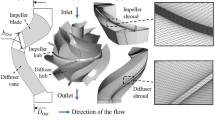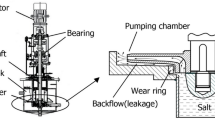Abstract
The performance of molten salt pump is affected by its geometrical structure and the physical properties of delivered fluids. In order to reveal the effects of these factors on pump performance, the performance curves were analyzed theoretically, the flow field was measured accurately by using high-speed photography, and the external characteristics were tested by using water as test medium. The numerical model was verified by the path lines, absolute velocity and performance curves obtained by experiment. Based on the verified model, the relationship among the fluid viscosity, external characteristics and flow field was investigated in the view of energy loss. The results show that reducing the blade outlet angle and outlet width as well as increasing the blade outlet thickness can avoid the unstable running. When delivering low viscosity fluids, since the impact loss is relatively large at low flow rate, the hump is easy to appear in the Head-Flow rate curve. When delivering high viscosity fluids, the opposite happens. With the increase of viscosity, the head and efficiency decrease monotonously, and the maximum efficiency point moves towards low flow rate. At the low flow rate, the shaft power decreases as the viscosity increases, while at the high flow rate, the shaft power increases as the viscosity increases. Compared with delivering water, when the viscosity is lower than 0.01453Pa⋅s, the drop of head and efficiency is less than 5%. The results of the study have reference significance on the development of high-performance molten salt pump and stable operation.














Similar content being viewed by others
Abbreviations
- b 2 :
-
Blade outlet width
- b 3 :
-
Volute inlet width
- D 2 :
-
Blade outlet diameter
- D 3 :
-
Base circle diameter
- D out :
-
Pump outlet diameter
- D s :
-
Pump inlet diameter
- F 2 :
-
Impeller effective flow area
- h f :
-
Friction loss, diffusion loss and bending loss
- h j :
-
Impact loss
- g :
-
Gravity acceleration
- H :
-
Actual head of pump with finite blades
- H d :
-
Design head
- H t :
-
Theoretical head of pump with finite blades
- H t∞ :
-
Theoretical head of pump with infinite blades
- K 1 :
-
Coefficient of friction loss, diffusion loss and bending loss
- K 2 :
-
Coefficient of impact loss
- n :
-
Pump rotational speed
- n d :
-
Design rotational speed
- n s :
-
Specific speed
- p :
-
Pressure
- P :
-
Shaft power
- Q :
-
Actual flow rate of pump with finite blades
- Q d :
-
Design flow rate
- Q t :
-
Theoretical flow rate of pump with finite blades
- Q t∞ :
-
Theoretical flow rate of pump with infinite blades
- r :
-
Radius
- s u :
-
Circumferential thickness of blade outlet
- SM :
-
Source term
- u :
-
Peripheral velocity of impeller
- v :
-
Absolute velocity of flow
- v:
-
Velocity
- w :
-
Relative velocity of flow
- z :
-
Blade number
- β 1 :
-
Blade inlet angle
- β 2 :
-
Blade outlet angle
- δ:
-
Identity matrix
- ΔQ :
-
Deviation between the actual flow rate and design flow rate
- η :
-
Pump efficiency
- φ 0 :
-
Tongue placed angle
- μ :
-
Dynamic viscosity
- μ eff :
-
Effective viscosity coefficient
- ρ :
-
Density
- σ :
-
Stodola slip coefficient
- ω :
-
Angular velocity of an impeller
- ψ 2 :
-
Blade outlet crowding coefficient
- Ω:
-
Rotational speed
References
Lee SH, Lee H, Kim JG (2013) Preliminary study on high temperature transport technology for molten salt in pyroprocessing. J Ind Eng Chem 19(5):1606–1610
Kergourlay G, Younsi M, Bakir F, Rey R (2017) Influence of splitter blades on the flow field of a centrifugal pump: test-analysis comparison. International Journal of Rotating Machinery 2007:1–13
Grapsas V, Stamatelos F, Anagnostopoulos J, Papantonis D (2008) Numerical study and optimal blade design of a centrifugal pump by evolutionary algorithms. Knowledge-Based Intelligent Information and Engineering Systems, Lecture Notes in Computer Science 5178:26–33
Spence R, Amaral-Teixeira J (2009) A CFD parametric study of geometrical variations on the pressure pulsations and performance characteristics of a centrifugal pump. Comput Fluids 38(6):1243–1257
Asuaje M, Bakir F, Kouidri S, Rey R (2004) Inverse design method for centrifugal impellers and comparison with numerical simulation tools. International Journal of Computational Fluid Dynamics 18(2):101–110
Shojaeefard MH, Tahani M, Ehghaghi MB, Fallahian MA, Beglari M (2012) Numerical study of the effects of some geometric characteristics of a centrifugal pump impeller that pumps a viscous fluid. Comput Fluids 60:61–70
Li WG (2000) Effects of viscosity of fluids on centrifugal pump performance and flow pattern in the impeller. Int J Heat Fluid Flow 21(2):207–212
Li WG (2008) Numerical study on behavior of a centrifugal pump when delivering viscous oils- Part 1: Performance. International Journal of Turbo and Jet Engines 25(2):61–79
Li WG (2008) Numerical study on behavior of a centrifugal pump when delivering viscous oils- Part 2: Internal flow. International Journal of Turbo and Jet Engines 25(2):81–94
Li WG (2011) Blade exit angle effects on performance of a standard industrial centrifugal oil pump. Journal of Applied Fluid Mechanics 4(2):105–119
Shojaeefard MH, Boyaghchi FA, Ehghaghi MB (2006) Experimental study and three-dimensional numerical flow simulation in a centrifugal pump when handling viscous fluids. Int J Eng Sci 17(3–4):53–60
Shojaeefard MH, Ehghaghi MB, Boyaghchi FA (2007) Studies on the influence of various blade outlet angles in a centrifugal pump when handling viscous. Am J Appl Sci 4(9):718–724
Shojaeefard MH, Tahani M, Khalkhali A, Ehghaghi MB, Fallah H, Beglari M (2013) A parametric study for improving the centrifugal pump impeller for use in viscous fluid pumping. Heat Mass Transf 49(2):197–206
Anagnostopoulos J (2009) A fast numerical method for flow analysis and blade design in centrifugal pump impellers. Comput Fluids 38(2):284–289
Zhou WD, Zhao ZM, Lee TS, Winoto SH (2003) Investigation of flow through centrifugal pump impellers using computational fluid dynamics. International Journal of Rotating Machinery 9(1):49–61
Cheah KW, Lee TS, Winoto SH, Zhao ZM (2007) Numerical flow simulation in a centrifugal pump at design and off-design conditions. International Journal of Rotating Machinery 2007:1–8
Feng J, Benra FK, Dohmen HJ (2009) Unsteady flow visualization at part-load conditions of a radial diffuser pump: by PIV and CFD. J Vis 12(1):65–72
Byskov RK, Jacobsen CB, Pedersen N (2003) Flow in a centrifugal pump impeller at design and off-design conditions-Part II: large eddy simulations. J Fluids Eng 125(1):73–83
Yang ZJ, Wang FJ, Zhou PJ (2012) Evaluation of subgrid-scale models in large-eddy simulations of turbulent flow in a centrifugal pump impeller. Chinese Journal of Mechanical Engineering 25(5):911–918
Kergourlay G, Younsi M, Bakir F, Rey R (2007) Influence of splitter blades on the flow field of a centrifugal pump: Test-Analysis Comparison. International Journal of Rotating Machinery 2007:85024-1–85024-8502413
Lucius A, Brenner G (2010) Unsteady CFD simulations of a pump in part load conditions using scale-adaptive simulation. Int J Heat Fluid Flow 31:1113–1118
Zhang F, Yuan SQ, Fu Q, Pei J, Böhle M, Jiang XS (2017) Cavitation-induced unsteady flow characteristics in the first stage of a centrifugal charging pump. J Fluids Eng 139(1):011303-1–011303-13
Zhang JY, Cai SJ, Zhu HW, Zhang YX (2015) Experimental investigation of the flow at the entrance of a rotodynamic multiphase pump by visualization. J Pet Sci Eng 126:254–261
Shao CL, Zhou JF, Cheng WJ (2015) Experimental and numerical study of external performance and internal flow of a molten salt pump that transports fluids with different viscosities. Int J Heat Mass Transf 89:627–640
FLUENT (2006) Copyright 2006 Fluent
Ren Y, Liu HL, Shu MH, Wu XF (2012) Analysis of applicability of turbulence models in performance prediction for centrifugal pumps at the off-design conditions. Fluid Machinery 40(10):18–22, 74 (in Chinese with English abstract)
Shao CL, Zhao Y (2017) Numerical study of the dimensionless characteristics and modeling experiment of a molten salt pump that transports viscous fluids. International Journal of Numerical Methods for Heat & Fluid Flow 27(9):2131–2153
Guan XF (2011) Modern pumps theory and design. China Astronautic Press, Beijing [in Chinese]
Acknowledgments
The work was supported by the National Natural Science Foundation of China (Grant No. 51306087), the Natural Science Foundation of Higher Education Institutions of Jiangsu Province (Grant No. 17KJA480003 and No. 18KJB470014), the Talents Project of Jiangsu Province of China (Grant No. GDZB-032) and the Jiangsu Key Laboratory of Green Process Equipment (Grant No. GPE201704).
Author information
Authors and Affiliations
Corresponding author
Ethics declarations
Conflict of interest statement
On behalf of all authors, the corresponding author states that there is no conflict of interest.
Additional information
Publisher’s Note
Springer Nature remains neutral with regard to jurisdictional claims in published maps and institutional affiliations.
Rights and permissions
About this article
Cite this article
Shao, C., Zhou, J. & Cheng, W. Effect of viscosity on the external characteristics and flow field of a molten salt pump in the view of energy loss. Heat Mass Transfer 55, 711–722 (2019). https://doi.org/10.1007/s00231-018-2450-z
Received:
Accepted:
Published:
Issue Date:
DOI: https://doi.org/10.1007/s00231-018-2450-z




